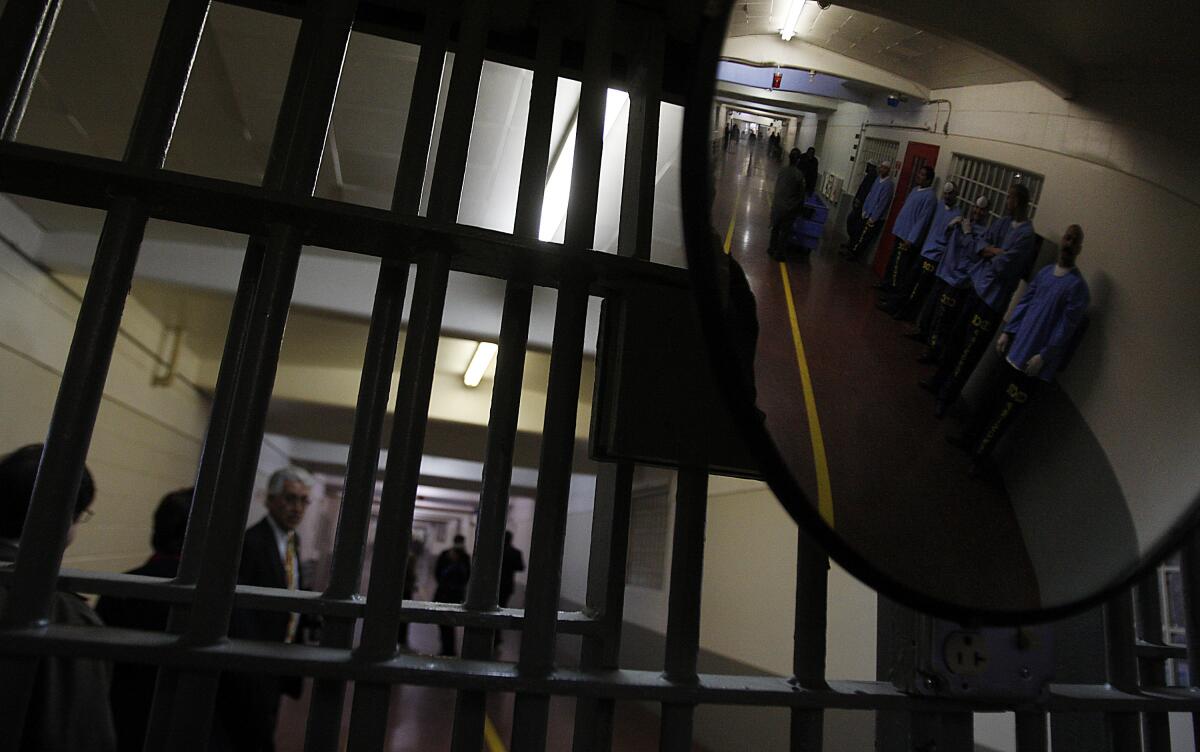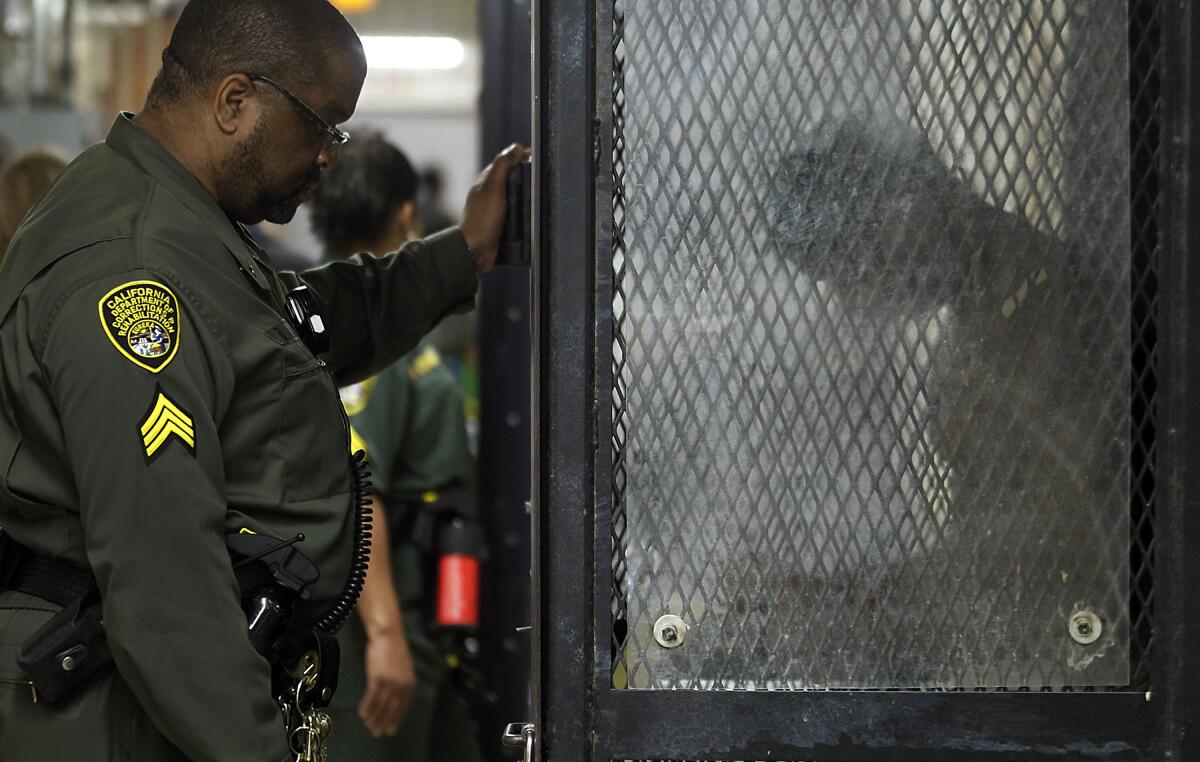Newsom Has Approved Three California Prison Closures but Resists Pressure to Shutter More
By Anabel Sosa April 1, 2024 3 AM PT

(Gary Coronado / Los Angeles Times)
SACRAMENTO —
Gov. Gavin Newsom went far beyond the promise he made in his first year in office to close at least one California state prison. But now, he is resisting calls from criminal justice advocates and liberal state lawmakers to shutter five more penitentiaries.
Shortly after taking office, Newsom placed a moratorium on the death penalty and has approved the closure of three prisons since 2019, but his administration appears to be pulling back from a 2022 budget proposal that considered “right-sizing California’s prison system” by possibly closing even more facilities. The administration fears that operating the state’s existing 31 prisons remains necessary to accommodate California’s fluctuating inmate population, enhance rehabilitation programs and avoid a repeat of the overcrowding that led to federal court intervention over a decade ago.
“The governor has a long track record of being on the progressive side of criminal justice. His belief that we can reduce prison populations and improve public safety is achievable. That’s the core of his goal,” said Michael Romano, director of the Three Strikes Project at Stanford University. “But the question of closing more prisons is complicated and goes beyond public safety. I don’t think they go as hand-in-hand as people want them to.”
Newsom finds himself in a precarious political spot. Crime was among the top issues that Californians want the Legislature and governor to work on in 2024, according to a Public Policy Institute of California poll released in February. But no matter what he decides to do, large swaths of California voters will disagree. On the one hand, he could disappoint liberal lawmakers and others advocating for the end of California’s tough-on-crime era of mass incarceration. On the other, he’d provoke moderates and conservatives concerned that prison and criminal justice reforms have gone far enough.
Sen. Steven Bradford (D-Gardena) and Assemblymember Mia Bonta (D-Alameda), both members of the Legislative Black Caucus whose priorities include prison reform, say they want more prisons to close.
Bradford said that he supports a more “holistic vision” of public safety.
“Investing in rehabilitation will pay dividends by reducing the revolving door of recidivism and will allow formerly incarcerated individuals to successfully re-integrate when they return home to their communities and families,” he told The Times in an email.
While serving in her former role as chair of the Assembly’s budget subcommittee on public safety, Bonta was outspoken about the opportunity California had to close more prisons.
“We have an insurmountable budget deficit,” she said, referring to the state’s $73-billion budget shortfall estimated by the Legislative Analyst’s Office. Bonta said the deficit is forcing the legislature to look for cuts.
The Legislative Analyst’s Office, which advises state lawmakers, suggested that over the next four years the state can save up to $1 billion annually if it closes five more prisons.
Sen. Roger Niello (R-Fair Oaks), the vice chair of the Senate Budget and Fiscal Review committee, told The Times that he disagreed with the prospect of more closures. He said there is a debate over whether crime rates are up and, because of that, uncertainty about whether prison populations will rise in the coming years. Niello also said the enactment of tougher new laws, including a ballot measure to reform Proposition 47, could lead to longer prison sentences for property and drug crimes and in turn higher incarceration rates.
Niello said closing five additional state correctional facilities would take capacity down to a “dangerously low level.”
The Newsom administration has no plans to close more prisons, said H.D. Palmer, a representative from the Department of Finance. Palmer told The Times that prison populations “can and do” fluctuate but said the numbers would not go up as dramatically as some worry.
“One thing we don’t want to go back to is where we had triple bunking in cells,” Palmer said. “But I don’t think we’d return to old numbers.”
The administration has to comply with a 2011 Supreme Court ruling that deemed overcrowding of prisons unconstitutional and ruled that prisons cannot exceed 137.5% of capacity. That same year, the state passed a law that relocated low-level offenders without prior serious or violent felonies to serve their time in a county jail instead of state prison.
There have been other efforts to reduce population swelling in the last decade.
Voters have passed various ballot measures, including Proposition 36 in 2012, which reformed the three-strikes law by imposing life sentences only for serious or violent crimes and not repeat offenders who commit minor, nonviolent crimes; Proposition 47 in 2014, which reduced some drug and property theft crimes from felonies to a misdemeanors; and Proposition 57 in 2016, which allows parole consideration of people convicted of nonviolent felonies, once they’ve already completed a prison term for their primary offense.
One year after the passage of Proposition 47, the prison and jail populations declined by 6% and 8.7%, respectively, according to a 2018 PPIC report. The report also noted court-ordered population reduction measures contributed to these dips.
The legislative analysts report noted that the administration has said that closing more prisons could create challenges, such as reducing the availability of treatment and reentry programs. The administration also states concerns over whether unexpected population increases in the future could raise the risks of overcrowding or even eliminate the necessity for prisoners to work some part-time and full-time jobs that provide them with a “meaningful way to occupy their time,” according to the LAO report.

But the legislative analyst’s report also found that the California Department of Corrections and Rehabilitation — which consumes $14.5 billion of the governor’s proposed 2024-2025 budget — should be able shut down more facilities due to dwindling costs.
The report said the department’s expenses have declined, specifically mentioning fewer confirmed COVID-19 cases, alleviating healthcare costs. The department spends $4.5 billion annually on healthcare, including mental health and dental work.
The report also cites a shrinking prison population, which fell by 34,000 over the last five years, the largest period of decline in the last decade. The population is projected to fall from 94,000 today to 85,000 inmates by 2027. There are currently 15,000 empty beds, and the analyst’s office projects an increase to 19,000 empty beds by 2028.
“The reality is that this generally means the upper bunk may be vacant, but the lower bunk is occupied by an incarcerated individual,” Palmer told The Times in an email. The population in some facilities still far exceeds the design capacity of one incarcerated person per cell or bunk.
The Newsom administration argues that having a lower population in a prison provides opportunities for more effective rehabilitation, since fewer people will be competing for the same programs.
While in theory, fewer inmates mean the state should be spending less, the department has accrued significant costs due to raises to correctional officers’ salaries and pensions and in part due to COVID-19.
The department estimates that it will save the state $778 million starting next year, after the closure of three state prisons: Deuel Vocational Institution in Tracy in 2021, California Correctional Center in Susanville in 2023, and Chuckawalla State Prison in Blythe, scheduled to close in March 2025.
California has also closed portions of various facilities across the state, and at the end of March will terminate its lease with the last private prison, California City Correctional Facility.
Californians United For a Responsible Budget, a statewide coalition whose mission is to identify wasteful prison spending, along with other organizations have gone as far as to demand the closure of 10 prisons. Their requests stretch beyond saving the state money and argue it is a way for the state to repurpose land and invest back into communities, including those where the local economies are impacted by prison closures.
The department remains under pressure to trim its budget. Senate lawmakers recently asked agency officials to consider cutting costs by as much as $2 billion, or 15% of its total budget, in addition to what the department planned to save through its recent prison closures.
Scott Graves, the director of research at California Budget & Policy Center, told The Times that while the state should close more prisons, he is skeptical whether the money saved from closures would resolve budget woes in the immediate short term.
“They can’t snap their fingers and close a prison,” he said. “Now the question is do we stop here or do we do more? Have we gone far enough?”
The Senate budget subcommittee on public safety held its first hearing in Februaryto discuss budget cuts and more prison closures.
Sen. Aisha Wahab (D-Hayward), who serves as the new subcommittee chair, told The Times that she is open to the idea of more closures but also wants to see more cuts where the budget is “bloated” and “wasteful.”
Wahab similarly said while she supports closing more prisons, the money California would save would not resolve the current budget shortfalls. She also said the state should more imminently address the shortage of correctional officers.

For the record:12:30 p.m. April 1, 2024
An earlier version of this article referred to California Sen. Brian Dahle (R-Bieber) as a state Assembly member.
Also, the story stated that Proposition 36 in 2012 dealt with drug possession and treatment. The measure reformed the three-strikes law.
Sen. Brian Dahle (R-Bieber), whose district includes Susanville, where the California Correctional Center closed in 2023, accused the Newsom administration of politicizing the decisions on which prison to shutter. Dahle suggested that the Susanville facility was targeted because it was in a Republican area of the state, a closure that “devastated our community.”
“The governor doesn’t always pick facilities that are the oldest and hardest to maintain. They do it for political reasons,” Dahle said.
Sen. Kelly Seyarto (R-Murrieta) expressed similar concerns about the upcoming closure of Chuckawalla Valley State Prison.
“I understand we have a lot of cuts still on the horizon. I’m a little distressed about Chuckawalla,” he said during the February budget hearing. “In the meanwhile, we’re leaving facilities open that are almost in dire need of being torn down.”
Secretary Jeff Macomber of the California Department of Corrections and Rehabilitation said during the Senate budget hearing in February that there will be multiple cuts to its budget, including the final closure of Chuckawalla. In total, the department has proposed $28.9 million in additional cuts for the upcoming fiscal year.
Wahab told Macomber it wasn’t enough.
“I’m not saying you shoulder the burden yourself,” she said, “but we expect a little more than this.”